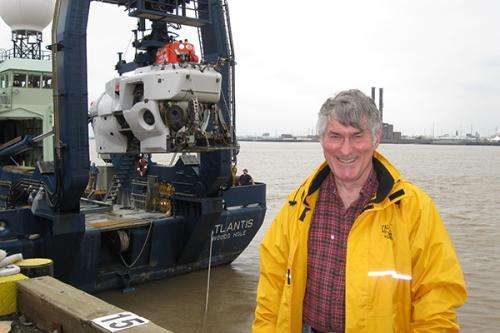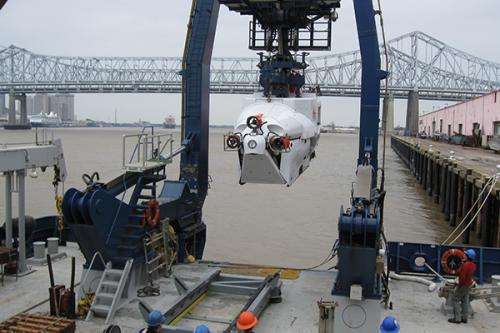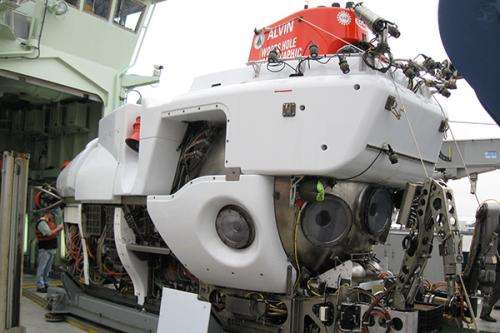Scientists assist field test of newly redesigned Alvin deep-sea submersible

Plunging into the depths of the ocean in the research submersible Alvin is like descending into another world. The inside of the sub is very dim, letting occupants' eyes adjust to darkness as daylight fades away. Bioluminescent fish and sea jellies flash their bluish lights outside the portholes. Scientists prepare their sampling equipment as the pilot maneuvers to the research site and then turns on the vehicle's headlights to get to work.
"It's one of the most intense days of science," said George Luther, Maxwell P. and Mildred H. Harrington Professor of Marine Studies in the University of Delaware's College of Earth, Ocean, and Environment (CEOE). "You're working the whole time, and you lose track of time a little bit. It's emotionally and physically exhausting."
Luther has made 14 trips deep beneath the sea in the famous sub. This month, he and other CEOE researchers will be among the 28-person scientific team testing the completely rebuilt Alvin, which has undergone a significant overhaul.
Progress of the field test, underway March 14-26 in the Gulf of Mexico, can be tracked at the cruise website with shipboard blog posts, photos and video. Catch updates by following CEOE's Twitter and Facebook accounts.
Alvin changed the way ocean exploration is done, taking scientists farther below the surface than ever before when first commissioned in 1964. The sub has been used to find a wayward World War II-era hydrogen bomb, investigate hydrothermal vents and examine the shipwrecked Titanic, among numerous other expeditions.
The vehicle has been out of service for the past three years as the 5-ton, titanium sphere was replaced, with scientists and engineers redesigning the frame and components that contain the sphere and doubling the science basket payload to 400 pounds. Enhancements include new LED lights, high-definition imaging systems, two more windows and an additional thruster that will let the sub hover in place like a helicopter.
In total, the upgrades are equivalent to deploying a whole new vehicle.

During the trial run, the scientists will test the new Alvin's navigation, data collection, speed, lighting, instrumentation, ergonomics and other capabilities so that researchers with new grants will know that the Alvin is fully operational. The team will sample systems around coral sites in the northern Gulf of Mexico off the Louisiana continental shelf. Waters there are only 3,000 meters deep, so the sub's maximum depth of 4,500 meters won't be tested until subsequent trials.
In fact, the titanium sphere has been upgraded to a depth rating of 6,500 from the previous rating of 4,500 meters, but there will need to be advancements in battery technology before the sub is ready to go that deep. As of now, the lithium-ion batteries needed for the time required to go that deep are not deemed safe by the U.S. Navy, which certifies the Alvin for field operations.
Alvin is one of the National Deep Sea Facility (NDSF) assets funded by the National Science Foundation and operated by Woods Hole Oceanographic Institution, but utilized by scientists from around the world.
Luther has used Alvin to examine the chemistry that vent organisms thrive in and discovered nanoparticles of pyrite coming out of deep-sea hydrothermal vents.
Luther has served as a member of the replacement Human-Occupied Vehicle Oversight Committee (RHOC) for the new Alvin since 2006. For the trial cruise, he'll bring his chemistry equipment designed by AIS Inc. on board for in situ testing.
"If all works, that means other newly funded people should have confidence that theirs will work, too," Luther said.

The March cruise includes both veteran researchers, like Luther, and early-career scientists. CEOE graduate student Dan MacDonald will be on board making real-time measurements to understand ocean chemistry and biology, as will School of Marine Science and Policy adjunct professor Don Nuzzio, who owns Analytical Instrument Systems Inc. and built Luther's electrochemical system.
Jonathan Cohen, who joined CEOE's faculty in 2011 as assistant professor of marine biosciences, will be on the cruise's second leg from March 22-25.
An expert in the visual ecology of marine organisms, Cohen will help assess the camera and video systems and biological sampling capabilities, particularly under low light, including mid-water sampling. He may not get to dive in Alvin this trip, but he will be well prepared for future cruises.
Luther remembers his first trip well: In 1999 he went to 9° 50' North East Pacific Rise, a fast-spreading hydrothermal vent site that had a series of eruptions in 2005 and 2006. He sat in the sub while it was still aboard the ship to get a feel for how it would be, but still was a little anxious before that first experience.
"It was really kind of cool," Luther said. "But if you're claustrophobic, it's not going to be a good trip."
Provided by University of Delaware



















